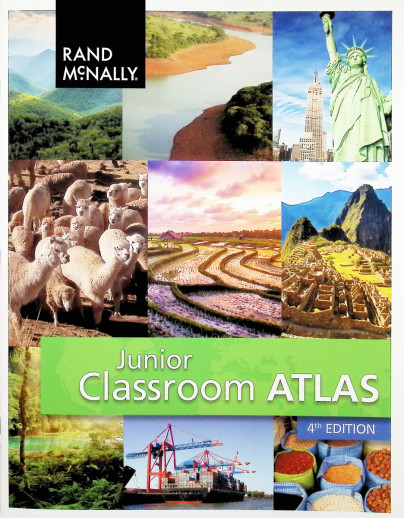We use cookies to make your experience better. To comply with the new e-Privacy directive, we need to ask for your consent to set the cookies. Learn more.
Junior Classroom Atlas, 4th Edition
With more maps and more detail, this is Rand McNally's next step up from the Primary Atlas (#037759). The colorful atlas begins with an overview of map and globe terminology, followed by world maps: a physical map, political map, world land use map, and climate map. Next is a United States political map, plus a section on U.S. regions and a timeline of original settlers and explorers, before moving on to political maps for all seven continents. Simple map legends are included for each map, as well as interesting facts, captioned photos of regional people, animals, or landmarks, and simple timelines/charts/graphs. Each of the maps in this atlas also contains a map question, challenging students to apply their map-reading skills. A glossary and index are provided at the back of the book. 48 pgs. ~ Lisa
Trust Rand McNally's Junior Classroom Atlas for the right amount and level of information for your elementary students. Our colorful, engaging atlas is ideal for students in second through fourth grades and was developed from our award-winning Classroom Atlas, just simplified for younger students.
Get all of our Junior Classroom Atlas products in one classroom package with our best buy value. You'll receive 30 student atlases and a teacher's guide to outfit your entire class with this must-have reference.
This book literally blazes a trail through geography - all you have to do is follow it! Cindy Wiggers has done a terrific job of combining questions, mapping, and other activities into a fun, easy-to-teach approach to geography. Intended as a thirty-six week program, the first twenty-seven of these include a variety of activities. The first weeks encompass the world as a whole; then you focus on different regions continent by continent. Within each week there are several different methods of learning. One of these, Geography Trails, provides questions four days a week that will improve the student's ability to use maps to locate countries, capitals, bodies of water, and landforms, teach them valuable geography terms and learn many geography facts. Different questions are given for grades 2-4, 5-7, and 8-10, so that you can use this book for children at different levels at the same time. Additional geography activities for every week are in the form of "Points of Interest," where you can take time to learn more extensively. Activities to choose from include mapping, researching, suggestions for art projects, and weekly projects to compile into your very own geography notebook. Then it's Geography through Literature for the last nine weeks as you read through Around the World in 80 Days. Questions for each chapter are provided, as are ideas for additional research and spelling and vocabulary words. Happy trails!
Please note that that this course provides a framework for studying world geography, and relies on additional resources for reference, maps, and activities. Required resources include: Around the World in 80 Days by Jules Verne (if you are planning on completing the literature portion of the study) and an age-appropriate world atlas (suggested atlases listed below). Three "key" recommended resources you will rely heavily on for many of the activities include the Ultimate Geography and Timeline Guide, Uncle Josh's Map Book (in book form, or CD-ROM), and Visual Manna's Teaching Geography Through Art (for the art in geography lessons). Although you could make the study work without these, they are often referred to in the lessons, and the program would work much more easily with them. These and other recommended resources are listed below, including atlases for students of different grades. Please note that the Jr. Classroom Atlas and Classroom Atlas are identical to the World Atlas Know Geography (Grades 1-3 and 4-9), respectively. The Atlas of World Geography and the World Atlas Know Geography for high school are almost identical with just a few textual changes. An almanac is also recommended, in case you don't have one on hand, we recommend the World Alamanac & Book of Facts. A Geographical Terms chart is also recommended; we are unable to offer this specifc one, but it is available from Geography Matters. Stephanie
| Product Format: | Softcover Book |
|---|---|
| Brand: | Rand McNally & Company |
| Grades: | 2-4 |
| ISBN: | 9780528026928 |
| EAN/UPC: | 070609026923 |
| Length in Inches: | 11 |
| Width in Inches: | 8.5 |
| Height in Inches: | 0.125 |
| Weight in Pounds: | 0.3313 |

